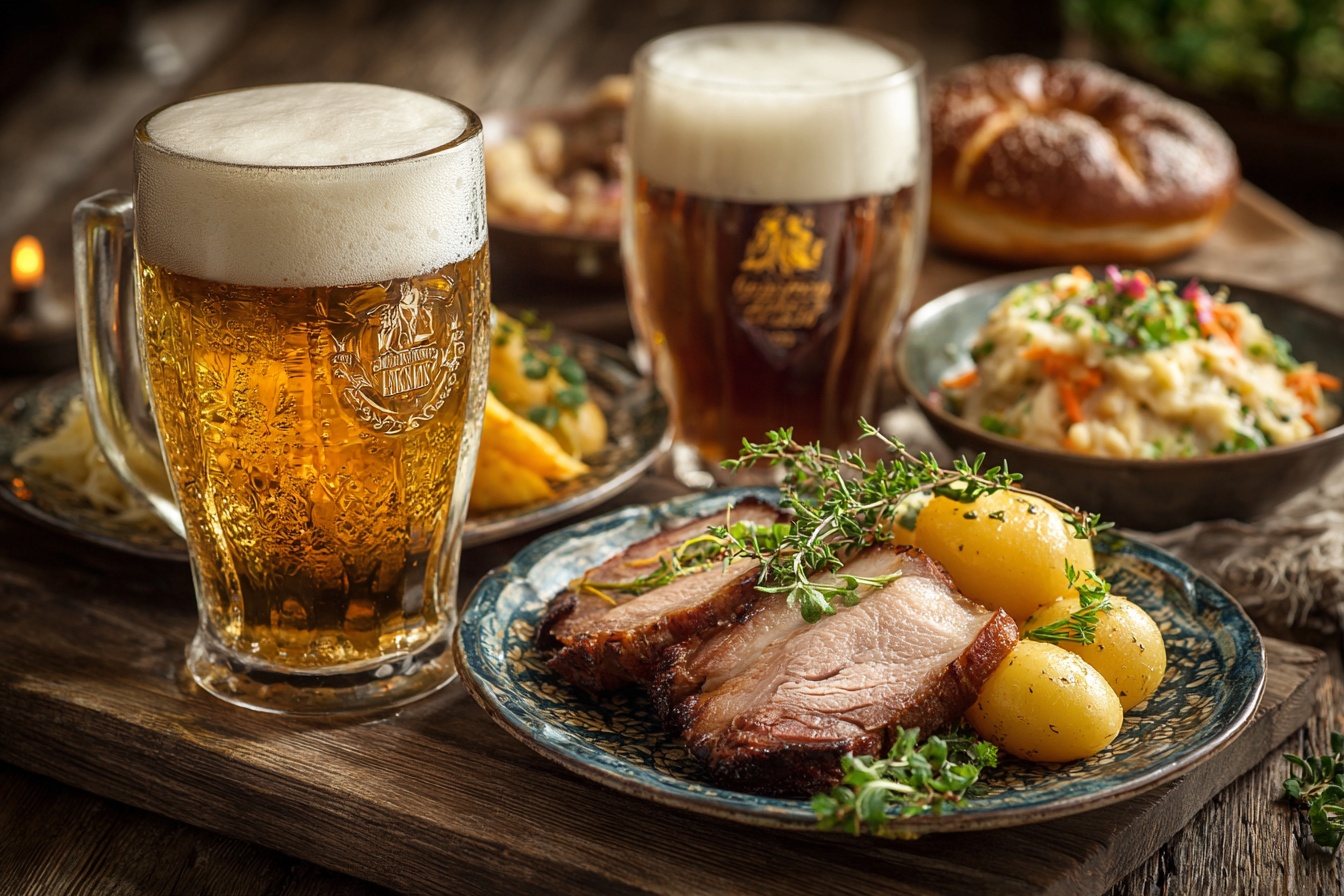Czech Pilsner stands out as one of the most beloved beer styles worldwide, thanks to its crisp, refreshing taste and balanced bitterness. Originating from the city of Pilsen in the Czech Republic, this golden lager has charmed beer lovers with its subtle malt sweetness combined with a distinct hop aroma. But beyond simply enjoying it on its own, Czech Pilsner offers exciting opportunities when paired with food. Its bright carbonation and clean profile make it an excellent companion to a wide variety of dishes, especially those from traditional Czech cuisine. In this culinary guide, we’ll explore how to best match Czech Pilsner with food, helping you elevate your beer experience to delicious new heights.
Understanding Beer and Food Pairing Principles
Before diving into specific pairings, it’s useful to understand the basic principles behind pairing beer and food. The goal of any pairing is to enhance the flavors of both the food and the beverage without one overpowering the other. Czech Pilsner is characterized by its moderate bitterness, light to medium body, and a crisp, dry finish, which makes it quite versatile in pairing.
The carbonation in Pilsners acts as a palate refresher, cleansing the mouth after each bite and sip. This property makes Pilsners especially good for richer, fattier foods, as the beer cuts through the heaviness neatly. Moreover, the mild malt sweetness balances saltiness and umami in many savory dishes, while the gentle hop bitterness adds an extra layer of complexity without overpowering delicate flavors.
When pairing beer with food, consider the intensity, flavor components, and texture of both. Lighter dishes match well with lighter beers, whereas heavier, more flavorful dishes often need a beer with stronger characteristics. Czech Pilsner, with its balanced flavor profile, fits well somewhere in the middle, bridging a wide range of culinary options.
Traditional Czech Dishes Paired with Pilsner
Since Czech Pilsner originated in the Czech Republic, it’s no surprise that it pairs seamlessly with many traditional Czech dishes. These pairings are time-tested and offer a glimpse into the culinary culture of the region.
- Svíčková na smetaně: This classic Czech dish features braised beef sirloin served with a creamy vegetable sauce and dumplings. The mild sweetness of the sauce complements the malt notes in the Pilsner, while the beer’s carbonation balances the rich creaminess.
- Knedlíky (Czech dumplings): These fluffy, steamed bread dumplings often accompany meat dishes and soaked sauces. The light texture and mild flavor of knedlíky go well with the crispness of the Pilsner, creating harmony on the palate.
- Roast pork with sauerkraut: A hearty plate of roast pork paired with tangy sauerkraut is another excellent companion. The Pilsner’s bitterness cuts through the fatty pork, while its malt backbone works well with the fermented flavors of the sauerkraut.
- Fried cheese (Smažený sýr): This popular Czech street food of breaded and fried cheese is indulgent and rich. The carbonation and bitterness of Czech Pilsner refresh the palate and balance the crispy fried textures, creating a classic snack experience.
- Beef goulash: Hearty and often mildly spicy, Czech-style goulash is enhanced by the light bitterness and refreshing finish of the Pilsner, which prevents the dish from feeling heavy.
Why Czech Pilsner Pairs Well with Savory and Fried Foods
The unique qualities of Czech Pilsner make it particularly suited for savory and fried foods. The beer’s moderate hop bitterness provides a clean, slightly bitter contrast that elevates the flavors of salty, fatty foods. Additionally, the effervescent carbonation plays a pivotal role in cutting through grease and cleansing the palate.
For fried foods like schnitzels, fried sausages, or crispy breaded cheeses, the bubbly texture of the Pilsner refreshes the senses, preventing the meal from feeling too heavy or greasy. The beer’s crisp nature is like a palate reset, readying you for another delicious bite.
When it comes to savory dishes, especially those rich in umami like roasted meats or gravies, the malt sweetness and bitterness in Czech Pilsner create a balanced interplay that enhances both the dish’s depth and the beer’s refreshing qualities. This harmony ensures neither the food nor the beer dominates, resulting in a highly enjoyable combination.
Pairing Czech Pilsner with Cheeses and Snacks
Czech Pilsner also shines when paired with a variety of cheeses and snack options. Because it is light and clean, it tends not to overpower delicate cheeses, yet can also hold its own against stronger varieties.
- Soft cheeses: Cheeses like Camembert, Brie, or young goat cheese complement the crisp and mild bitterness of Pilsner without overshadowing the beer.
- Semi-hard cheeses: Varieties like Edam, Gouda, and mild Cheddar work well by adding a layer of richness that pairs with the malt sweetness.
- Hard and aged cheeses: While very strong cheeses might overpower a delicate Pilsner, moderate aged cheeses like Parmesan or aged Asiago can provide a nice salty tang that balances the beer’s hop bitterness.
- Snack foods: Pretzels, salted nuts, pickles, and even potato chips all find a delicious companion in Czech Pilsner. These snacks share salty and savory qualities that harmonize with the beer’s crisp profile.
Seasonal Pairing Ideas with Czech Pilsner
Czech Pilsner’s versatility also makes it a great choice for seasonal dining experiences, adapting well to different weather and mood-driven menus.
- Spring & Summer: Light salads with vinaigrette, grilled vegetables, and seafood like white fish or shrimp offer refreshing pairings that match Czech Pilsner’s crispness. The beer’s refreshing quality is perfect to cool you down on a warm day.
- Autumn: Heartier vegetables such as roasted root vegetables, mushrooms, and pumpkin-based dishes complement Pilsner’s malt backbone, pairing beautifully with the earthy, autumnal flavors.
- Winter: Rich stews, roasted meats, and traditional comfort foods like pork knuckles or goose take advantage of the beer’s ability to balance savory intensity and cut through fat, making it an inviting option for cold-weather meals.
Tips for Hosting a Czech Pilsner Tasting Dinner
If you’re looking to share the joy of Czech Pilsner with friends or family, hosting a tasting dinner can be a fun and memorable experience. Here are some tips to make the event a success:
- Select a range of Pilsners: If possible, provide a few different Czech Pilsners from various breweries to taste nuances in bitterness, malt characteristics, and carbonation levels.
- Plan a thoughtful menu: Include traditional Czech dishes and snacks alongside some creative pairings. Start with lighter appetizers like pretzels and cheese, move on to fried cheese or sausages, and finish with a rich roasted meat dish.
- Use appropriate glassware: Serve Czech Pilsners in tall, slender pilsner glasses to showcase the beer’s color, clarity, and carbonation.
- Share tasting notes: Encourage guests to note the flavors and textures they experience both in the beer and the food, making the evening interactive and educational.
- Keep the serving temperature ideal: Pilsners are best enjoyed cold but not ice cold—around 40-45°F (4-7°C) to bring out crispness without dulling flavor.
Elevating Your Experience Through Thoughtful Pairing
Czech Pilsner’s balanced and refreshing nature makes it a flexible and rewarding beer for pairing with a variety of foods, from traditional Czech dishes to cheeses and seasonal fare. Whether you’re enjoying a comforting plate of roast pork and sauerkraut or snacking on pretzels and cheese with friends, the right pairing can heighten the flavors and make every bite and sip more enjoyable.
Experimenting with different combinations, understanding the principles behind pairing, and sharing these experiences in a tasting setting can deepen your appreciation of both Czech pilsners and the accompanying culinary delights. Next time you pour a cold Czech Pilsner, consider how its crisp profile can interact with your meal, and unlock a whole new level of flavor harmony and satisfaction.







